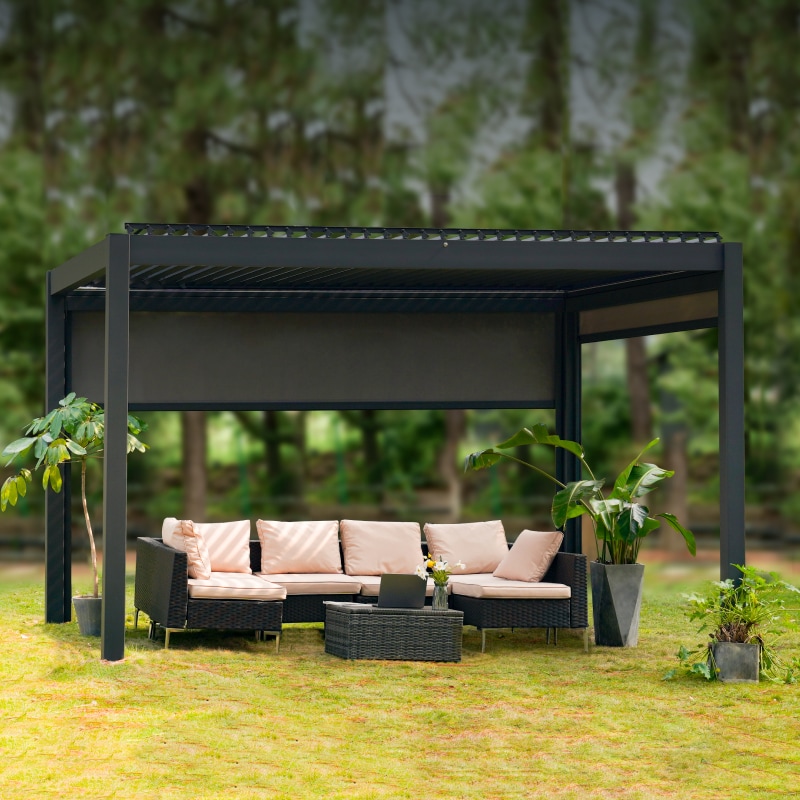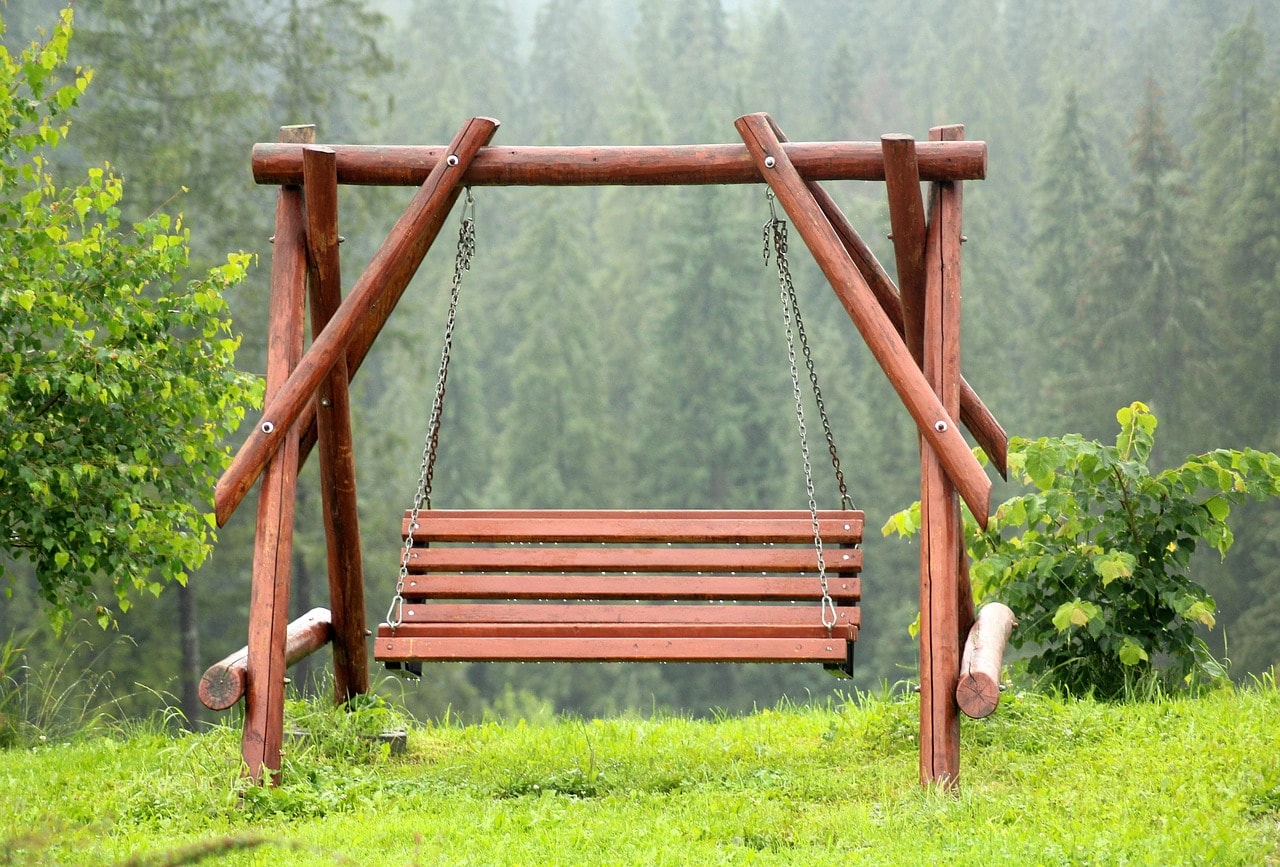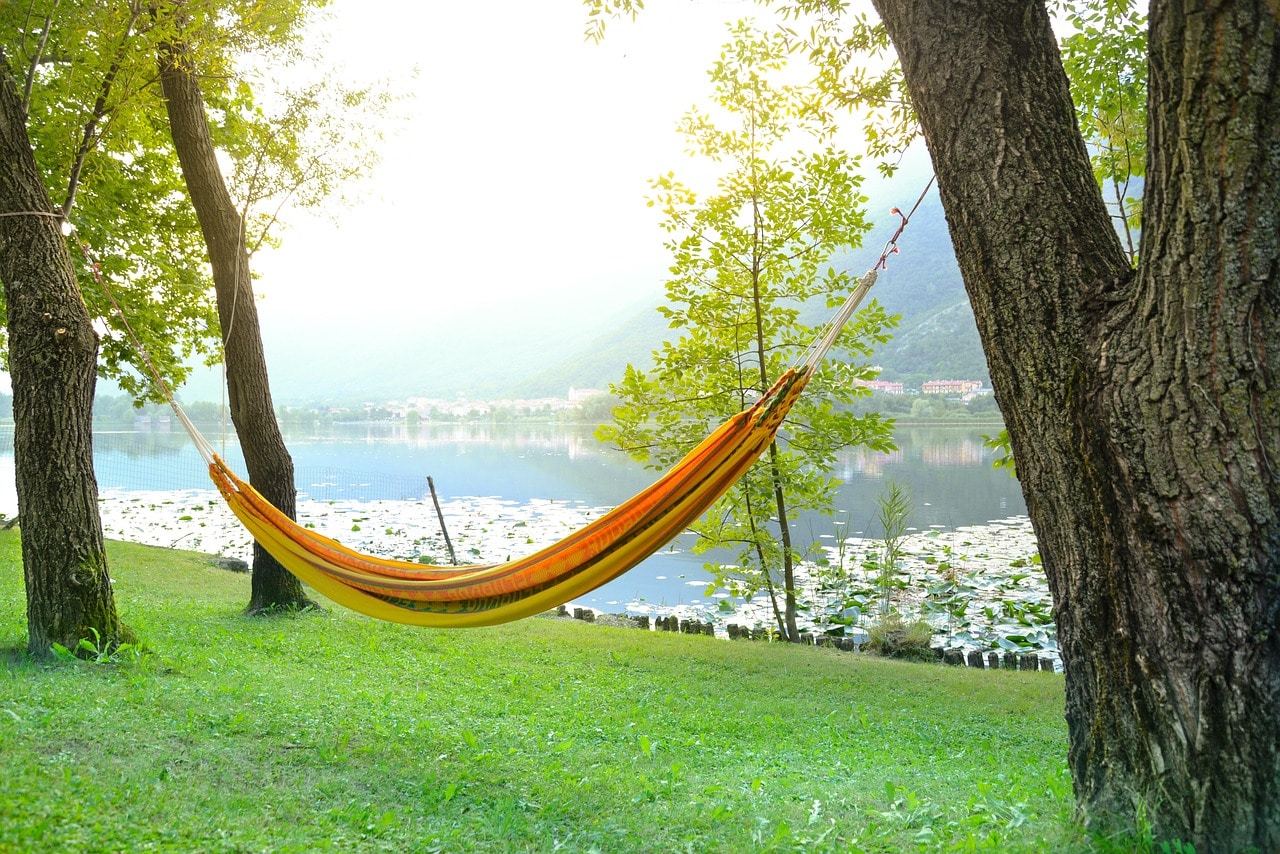A pergola swing can instantly elevate your backyard—adding comfort, charm, and a touch of fun. But before you start drilling hooks or hanging chains, it’s important to understand the structural and safety factors involved. In this guide, we’ll walk you through everything from choosing the right type of swing to installing it safely, plus creative alternatives if a swing isn’t the right fit.
Can a Pergola Support a Swing?
In many cases, yes—a pergola can support a swing, but only if it meets certain structural requirements. While pergolas are designed to handle environmental loads like wind or light snow, a hanging swing applies a very different kind of stress: a concentrated, dynamic load that moves back and forth. Here are the key factors to help determine if your pergola is swing-ready:

1. Material
The type of material your pergola is made from plays a huge role in its overall strength.
- Wood pergolas, especially those made from pressure-treated pine, cedar, or redwood, can generally support heavy loads—often 250 lbs or more per beam, assuming solid construction. These are commonly used for swing setups.
- Aluminum pergolas are known for their weather resistance and sleek look, but they vary widely in strength. High-quality aluminum can support roughly 8–15 pounds per square foot, depending on thickness and design, but lighter-duty models may not be suitable for swings.
- Vinyl pergolas are lower maintenance but typically have an internal aluminum or wood core for strength. Their load capacity depends on that inner structure—many are more decorative and not ideal for supporting a swing unless reinforced.
2. Size and Scale
Bigger pergolas don’t automatically mean stronger pergolas. However, a well-built, larger pergola with thick beams and multiple posts is more likely to distribute weight safely.
- A 10' x 10' pergola with 6" x 6" posts and solid cross-beams can often support a two-person swing (up to 500 lbs), while a lightweight 8' x 8' structure with narrow posts may only be safe for hanging plants or lights.
- Keep in mind that the longer the span between posts, the more stress will be placed on the center of the beam. If your pergola has wide openings between supports, additional bracing or beam reinforcement may be needed.
3. Design and Joinery
The engineering behind the pergola matters just as much as materials or size. A well-designed structure with cross-bracing, secure joints, and load-bearing center beams will naturally carry more weight. Look for:
- Beams at least 2" x 6" or larger for load-bearing strength
- Posts securely anchored into concrete or reinforced deck framing
- Metal brackets or joinery hardware that minimize movement or sway
4. Installation Quality
Even a strong pergola can fail if it's not properly installed. Swings put dynamic, shifting loads on beams, especially when in use. That makes proper anchoring and stable footing absolutely essential. Ensure your pergola is:
- Anchored with concrete footings or metal post brackets
- Reinforced with hardware rated for outdoor and structural use
- Regularly inspected for wood rot, rust, or joint loosening
5. Swing Weight and Dynamics
It’s not just about how much the swing weighs while sitting still. Dynamic weight—the force exerted when the swing is in motion—can significantly exceed the static weight. As the swing moves, it multiplies the load on the beam, especially with more forceful swinging.
Also, factor in the type of swing and the occupants’ combined weight. A single hanging chair might be 50–100 lbs with a person on it, but a large porch swing with two adults can easily exceed 400–600 lbs in motion. Always make sure your pergola can handle both the swing + user weight, especially under movement.
Final Tip:
When in doubt, consult a professional or structural engineer before adding a swing. Many manufacturers list the weight ratings for their pergolas, and exceeding these limits can lead to serious safety risks.

Popular Pergola Swing Styles
One of the most exciting parts of creating a swinging pergola setup is choosing the perfect swing style to match your space. From cozy solo seats to luxurious bed swings, pergola swings come in all shapes and designs to suit your comfort and aesthetic preferences. Below are some of the most popular styles to consider when planning your pergola with swing.
1. Classic Porch Swings
A timeless favorite, porch swings bring that nostalgic, front-porch charm to any outdoor space. Typically bench-style and suspended with chains or ropes, these swings are ideal for two people and are available in wood, metal, or wicker finishes. Whether you’re sipping coffee or enjoying a sunset, a classic porch swing under your pergola offers the perfect place to unwind.
2. Single or Double Hanging Chairs
For smaller pergolas or cozier seating areas, hanging chairs—either single or double—are a stylish and space-saving option. These pergola swings are often shaped like an egg or a cocoon, offering both comfort and a sense of privacy. Materials like woven rattan or metal add to the contemporary look, and they pair beautifully with modern aluminum pergolas or adjustable-louver designs.
3. Rope Swings
Simple yet full of personality, rope swings are often made from hardwood like oak and suspended by durable rope or nautical-grade cord. They can be minimalist—just a wooden plank seat—or feature custom designs like macrame or engraved wood. Rope swings work well in rustic or natural-style pergolas and can be hung from central beams for a clean, playful touch.
4. Swing Beds
For the ultimate outdoor lounging experience, swing beds offer unmatched comfort. These oversized swings combine the relaxing motion of a hammock with the support of a daybed. Most models can accommodate one to two adults lying down or multiple people seated. Upholstered cushions and outdoor fabrics add luxury, making swing beds a standout feature under a large, sturdy swinging pergola.
5. Hammock Swings & Lounge Swings
Somewhere between a hanging chair and a swing bed, hammock swings are ideal for reading, napping, or simply swaying in the breeze. These swings cradle the body and are often made from canvas, mesh, or woven fabrics. If you have a pergola with adjustable louvers, a hammock swing is a great match—it allows you to control sunlight and airflow while enjoying a semi-enclosed feel.
6. Material Choices: Wood vs. Metal
When selecting your pergola swing, consider the material as it impacts both the style and durability.
- Wooden swings offer a classic, natural look that pairs beautifully with traditional or rustic pergolas. Cedar, teak, and pine are common choices.
- Metal swings (like aluminum or wrought iron) are sleek and often better suited for modern, minimalist spaces. They typically require less maintenance and resist weathering.
How to Attach a Swing to a Pergola? Step-by-Step
Adding a swing to your pergola can elevate your outdoor space—but only if it’s done safely and securely. Attaching a swing is more than just drilling in a few hooks; it requires thoughtful planning, strong materials, and attention to structural details. Here’s a step-by-step breakdown to help you install your pergola swing with confidence.
1. Gather Your Materials
Before you begin, make sure you have the right hardware and tools in hand. Here’s what you’ll typically need:
- Heavy-duty swing hangers (J-hooks or eye bolts rated for 250–500 lbs)
- Chains or ropes rated for outdoor use and your expected load
- Quick links or carabiners for connecting chains/ropes to hangers
- Drill with appropriate drill bits
- Wrenches or socket set
- Level and measuring tape Optional: Spring clips, shock absorbers, or anti-sway hardware for smoother swinging.
2. Identify Structural Support Beams
The most important step is identifying the right place to hang your swing.
- Use the beams—not rafters or slats. Beams are horizontal supports that run across the top of your pergola and are built to carry weight.
- Avoid attaching to smaller slats or decorative rafters—they aren’t strong enough to support a swing.
- Measure and mark two points on the same beam, spaced about 18–24 inches wider than the swing seat itself for stability.
If you’re using a double beam or attaching between two beams, make sure both can handle the weight independently and are anchored securely.
3. Install the Swing Hardware
Once you’ve marked the support points:
- Drill pilot holes through the beam where the hooks will go. This helps prevent splitting and ensures a snug fit.
- Insert the swing hangers or eye bolts and tighten with washers and nuts if needed (especially for through-bolt designs).
- Attach chains or ropes to your swing seat, then connect them to the hooks using quick links or carabiners.
- Use a level to make sure your swing hangs evenly and adjust the length of the chains or ropes as needed.
4. Check Weight Ratings and Load Balance
Always double-check that all components are rated for the combined weight of the swing, plus the people using it.
- A two-person swing may require support for 400–600 lbs total when accounting for dynamic motion.
- Chains, anchors, and hardware should all exceed the estimated load.
- For long-span pergolas, consider adding cross-bracing or reinforcement under the beam to distribute the load.
5. Test and Maintain
Before using the swing:
- Apply pressure gradually to the seat while checking for any creaking, shifting, or looseness in the beam or hardware.
- Perform a few gentle test swings to observe motion and ensure stability.
- If the pergola shakes or the beam flexes, stop and reassess your setup—additional bracing may be needed.
Regularly inspect the swing and mounting points for:
- Rust or wear on chains, bolts, and quick links
- Wood cracks or splits near attachment points
- Loose hardware or signs of movement
Re-tighten or replace parts as necessary. For maximum safety, especially with swing beds or larger lounge swings, it’s worth having a contractor or engineer verify your setup.

Safety Tips for Using Pergola Swings
While pergola swings can bring comfort and charm to your outdoor space, safety should always come first—especially if kids are involved. Whether you’re installing a cozy two-seater or a pergola swing for kids, following these safety guidelines can help you enjoy worry-free swinging.
1. Choose the Right Swing for Your Needs
- For families with children, consider a swing designed specifically for kids—such as bucket-style baby swings or models with built-in safety harnesses.
- If you're installing a larger swing like a three-person bench, make sure your pergola structure is rated to support at least 500–600 lbs, including dynamic motion.
- Swings made from softer materials like rubber or padded fabric are preferable for young children to minimize the risk of bumps or bruises.
2. Ensure Proper Clearance and Placement
- Allow at least 6 feet of clear space in front and behind the swing for safe swinging.
- Keep the swing away from walls, posts, or sharp-edged furniture.
- For pergola swings installed on patios or decks, consider adding soft landing zones—like rubber mats or outdoor rugs—to reduce impact from falls.
3. Child-Specific Safety Additions
- Install non-slip mats under the swing to reduce the chance of slipping or tripping.
- Consider side safety rails for toddler swings to help keep little ones securely in place.
- For added peace of mind, place your swing in a spot that allows for easy adult supervision.
4. Pre-Use Installation & Safety Checklist
Before using your swing, run through this quick checklist:
- ✅ Are your support beams strong enough to handle the load?
- ✅ Are the swing hangers or eye bolts properly installed and rated for outdoor use?
- ✅ Are the chains or ropes free from fraying, rust, or damage?
- ✅ Is the swing hanging evenly and secured tightly?
- ✅ Are all nearby surfaces level and obstacle-free?
Regular maintenance is key—check your hardware, tighten bolts, and replace worn components as needed.
5. Safe Swinging Habits
- Always sit while swinging—never stand or jump off.
- Supervise kids at all times, and teach them to hold on with both hands.
- Discourage horseplay or pushing too hard.
- Wear fitted clothing to avoid catching loose fabric or drawstrings in the swing hardware.

Pergola Swing Alternatives: Other Relaxing Outdoor Options
Not every backyard calls for a traditional swing. Whether you're short on space, concerned about weight capacity, or just want a different kind of lounging experience, there are plenty of swing alternatives that deliver the same sense of relaxation—without the need for a classic hanging bench. Here are some stylish and practical options to consider:
1. Hammocks
For ultimate relaxation, few things beat a hammock gently swaying in the breeze. Whether strung between pergola beams or placed on a freestanding frame, hammocks offer a casual, space-efficient alternative to pergola swings. You can choose a simple fabric hammock, a woven style for a beachy feel, or even a hammock chair for an upright lounge option. Hammocks with built-in stands are especially great for renters or those who want flexibility without drilling into pergola posts.
2. Hanging Daybeds
If you love the idea of a swing but want something roomier and more plush, a hanging daybed might be your dream setup. These oversized swing alternatives combine the best of a bed and a bench swing—perfect for napping, reading, or lounging with a drink. For added comfort and privacy, consider placing a daybed under a pergola with adjustable louvers or pairing it with flowing curtains and a canopy.
3. Swing Chairs and Egg Chairs
Looking for something compact yet eye-catching? A single swing chair, like a macrame or egg-style chair, offers a fun and cozy perch that fits well in smaller spaces. These are ideal for modern patios and can either be hung from a pergola beam (if structurally reinforced) or placed on a freestanding base for added flexibility. They're one of the easiest ways to get that "swinging" sensation without a full setup.
4. Freestanding Swing Sets or Frames
If you’re worried about your pergola’s ability to support a swing, consider a freestanding swing frame. These units provide their own structural support, so you can place them under your pergola for the look and feel without putting strain on the beams. It’s a safe and stylish workaround that also gives you the freedom to reposition the swing as needed.
Conclusion
With the right planning, materials, and installation, a pergola swing can become your favorite spot to relax, read, or enjoy time with loved ones. Whether you go for a classic porch swing or a modern hanging chair, safety and structure are key. For a durable, stylish option that’s engineered to handle weight with ease, consider the Villardin aluminum pergola—designed to support swings and elevate your outdoor space in every way.
FAQs About Pergola Swings
1. What size pergola is best for adding a swing?
A pergola that’s at least 10' x 10' with 6" x 6" posts and strong cross-beams is ideal. Smaller pergolas may not offer enough space for clearance or may require structural reinforcement. For swing beds or multi-person seats, a larger footprint ensures better safety and comfort.
2. What’s the best swing type for kids under a pergola?
For young children, look for bucket-style swings or swings with safety harnesses. Soft rope or rubber swings are also safer than rigid wood or metal seats. Always supervise children and make sure the swing is securely installed.
3.How much does it cost to add a swing to a pergola?
Costs can vary widely. A simple hanging chair might only cost $100–$300, while a full pergola swing bed setup could run $800–$2,500, especially if structural reinforcement or professional installation is needed.
4. Are there shade options I can pair with a pergola swing?
Definitely. Many people combine swings with shade features like retractable canopies, outdoor curtains, or pergolas with adjustable louvers to create a cooler, more comfortable lounging zone.